Abstract
A monoclonal antibody capable of binding to determinants shared in common by staphylococcal enterotoxin serotypes A, B, C1, D, and E was developed. To accomplish this, BALB/c mice were immunized by alternating injections of serotypes A and D to enrich for spleen lymphocytes programmed to produce antibody to possible common determinants. These cells, fused with mutant myeloma cells (P3-X-63Ag8.653) produced hybrids that formed monoclonal antibodies to either serotype A only or to both serotypes A and D. A cloned hybridoma from the latter group produced an antibody (subclass immunoglobulin G1) which interacted with five serotypes. Highest affinity was to B and C1. An immunomatrix consisting of this antibody cross-linked to protein A-Sepharose CL-4B with dimethyl pimelimidate was capable of binding enterotoxin. Bound toxin was eluted with diethylamine. Because of its ability to interact with all five serotypes, the monoclonal antibody should prove useful in the development of a rapid method for screening foods for the presence of staphylococcal enterotoxin.
Full text
PDF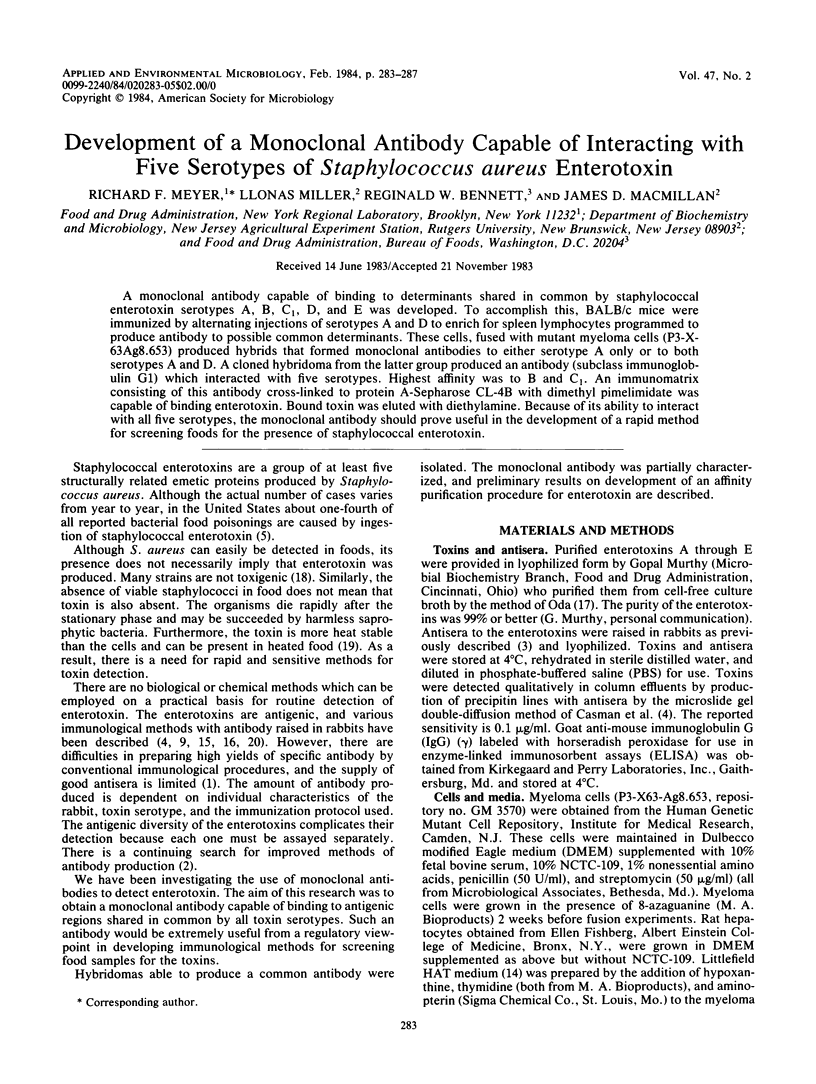
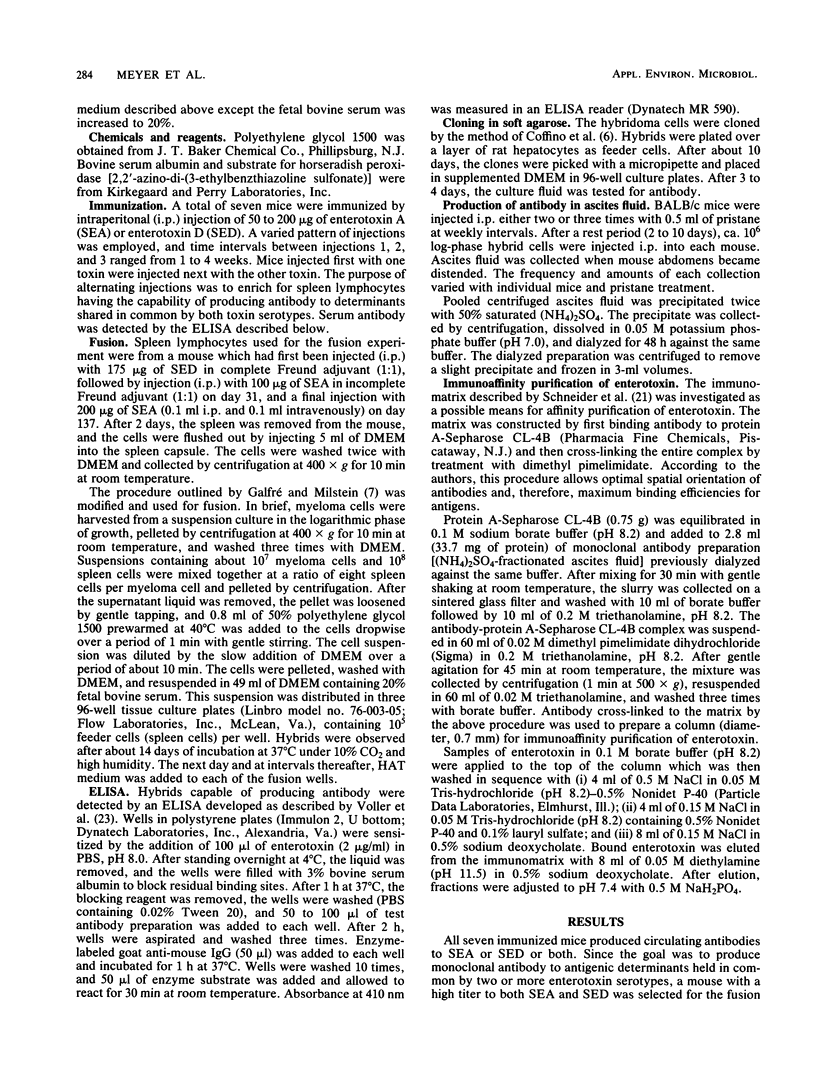
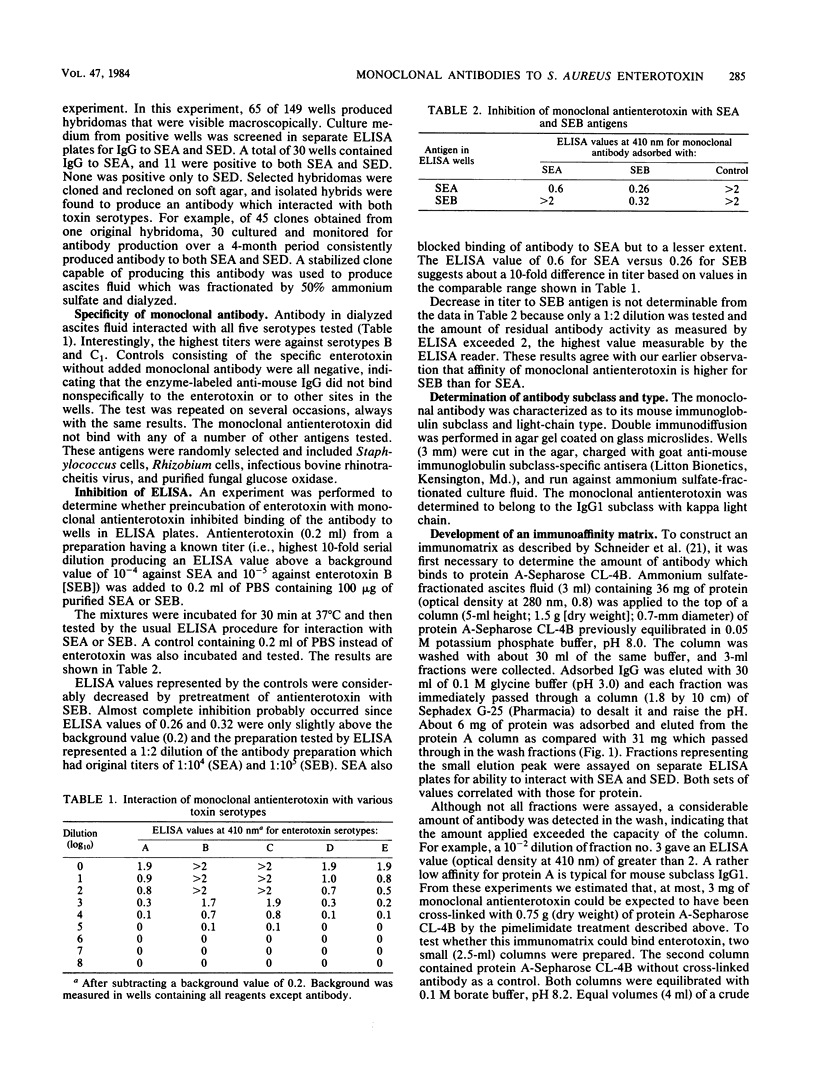
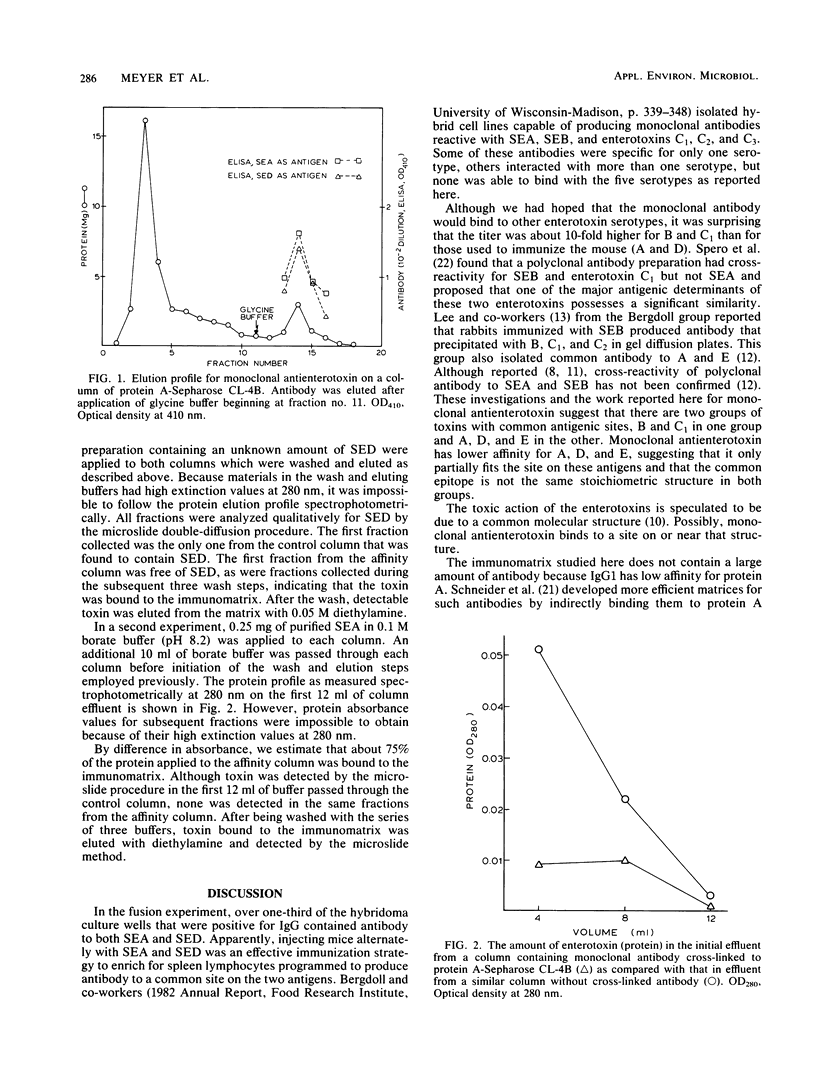
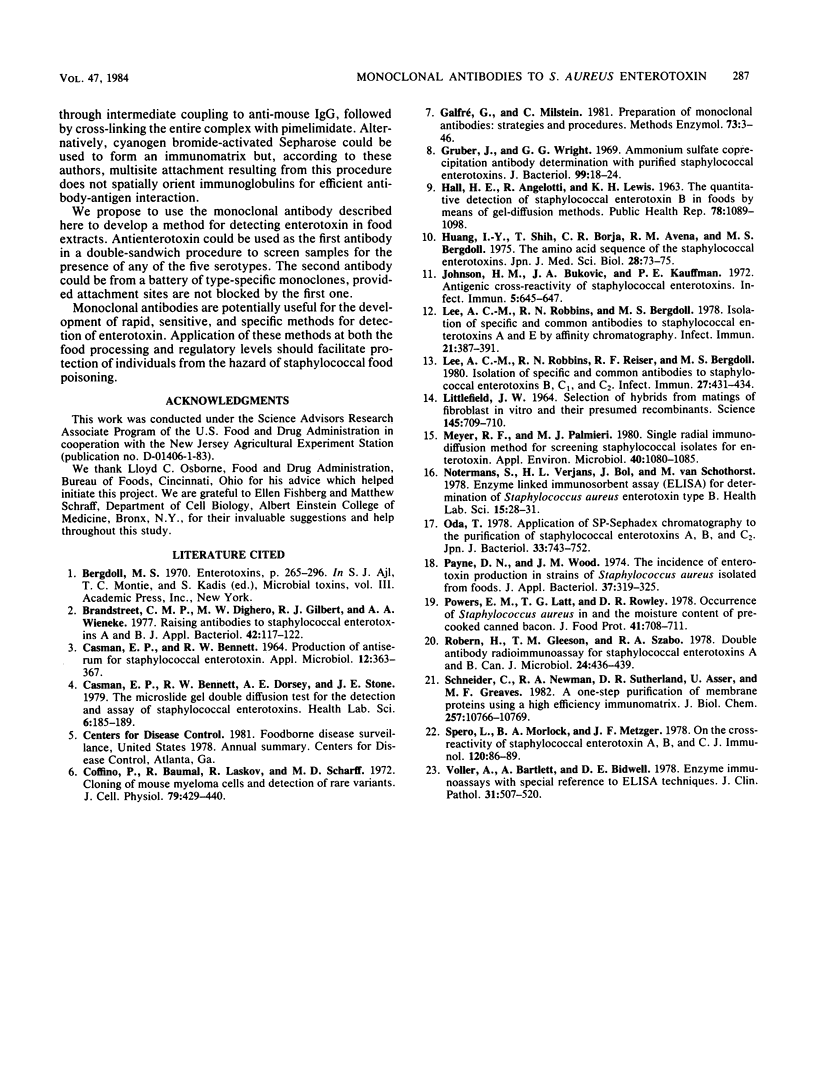
Selected References
These references are in PubMed. This may not be the complete list of references from this article.
- Bradstreet C. M., Dighero M. W., Gilbert R. J., Wieneke A. A. Raising antibodies to staphylococcal enterotoxins A and B. J Appl Bacteriol. 1977 Feb;42(1):117–122. doi: 10.1111/j.1365-2672.1977.tb00675.x. [DOI] [PubMed] [Google Scholar]
- CASMAN E. P., BENNETT R. W. PRODUCTION OF ANTISERUM FOR STAPHYLOCOCCAL ENTEROTOXIN. Appl Microbiol. 1964 Jul;12:363–367. doi: 10.1128/am.12.4.363-367.1964. [DOI] [PMC free article] [PubMed] [Google Scholar]
- Casman E. P., Bennett R. W., Dorsey A. E., Stone J. E. The micro-slide gel double diffusion test for the detection and assay of staphylococcal enterotoxins. Health Lab Sci. 1969 Oct;6(4):185–198. [PubMed] [Google Scholar]
- Coffino P., Baumal R., Laskov R., Scharff M. D. Cloning of mouse myeloma cells and detection of rare variants. J Cell Physiol. 1972 Jun;79(3):429–440. doi: 10.1002/jcp.1040790313. [DOI] [PubMed] [Google Scholar]
- Galfrè G., Milstein C. Preparation of monoclonal antibodies: strategies and procedures. Methods Enzymol. 1981;73(Pt B):3–46. doi: 10.1016/0076-6879(81)73054-4. [DOI] [PubMed] [Google Scholar]
- Gruber J., Wright G. G. Ammonium sulfate coprecipitation antibody determination with purified staphylococcal enterotoxins. J Bacteriol. 1969 Jul;99(1):18–24. doi: 10.1128/jb.99.1.18-24.1969. [DOI] [PMC free article] [PubMed] [Google Scholar]
- HALL H. E., ANGELOTTI R., LEWIS K. H. QUANTITATIVE DETECTION OF STAPHYLOCOCCAL ENTEROTOXIN B IN FOOD BY GEL-DIFFUSION METHODS. Public Health Rep. 1963 Dec;78:1089–1098. [PMC free article] [PubMed] [Google Scholar]
- Huang I. Y., Schantz J., Bergdoll M. S. Proceedings: The amino acid sequence of the staphylococcal enterotoxins. Jpn J Med Sci Biol. 1975 Feb;28(1):73–75. [PubMed] [Google Scholar]
- Johnson H. M., Bukovic J. A., Kauffman P. E. Antigenic cross-reactivity of staphylococcal enterotoxins. Infect Immun. 1972 May;5(5):645–647. doi: 10.1128/iai.5.5.645-647.1972. [DOI] [PMC free article] [PubMed] [Google Scholar]
- LITTLEFIELD J. W. SELECTION OF HYBRIDS FROM MATINGS OF FIBROBLASTS IN VITRO AND THEIR PRESUMED RECOMBINANTS. Science. 1964 Aug 14;145(3633):709–710. doi: 10.1126/science.145.3633.709. [DOI] [PubMed] [Google Scholar]
- Lee A. C., Robbins R. N., Bergdoll M. S. Isolation of specific and common antibodies to staphylococcal enterotoxins A and E by affinity chromatography. Infect Immun. 1978 Aug;21(2):387–391. doi: 10.1128/iai.21.2.387-391.1978. [DOI] [PMC free article] [PubMed] [Google Scholar]
- Lee A. C., Robbins R. N., Reiser R. F., Bergdoll M. S. Isolation of specific and common antibodies to staphylococcal enterotoxins B, C1, and C2. Infect Immun. 1980 Feb;27(2):431–434. doi: 10.1128/iai.27.2.431-434.1980. [DOI] [PMC free article] [PubMed] [Google Scholar]
- Meyer R. F., Palmieri M. J. Single radial immunodiffusion method for screening Staphylococcal isolates for enterotoxin. Appl Environ Microbiol. 1980 Dec;40(6):1080–1085. doi: 10.1128/aem.40.6.1080-1085.1980. [DOI] [PMC free article] [PubMed] [Google Scholar]
- Notermans S., Verjans H. L., Bol J., van Schothorst M. Enzyme linked immunosorbent assay (ELISA) for determination of Staphylococcus aureus enterotoxin type B. Health Lab Sci. 1978 Jan;15(1):28–31. [PubMed] [Google Scholar]
- Oda T. [Application of SP-sephadex chromatography to the purification of staphylococcal enterotoxins A, B and C2 (author's transl)]. Nihon Saikingaku Zasshi. 1978;33(6):743–752. [PubMed] [Google Scholar]
- Payne D. N., Wood J. M. The incidence of enterotoxin production in strains of Staphylococcus aureus isolated from foods. J Appl Bacteriol. 1974 Sep;37(3):319–325. doi: 10.1111/j.1365-2672.1974.tb00446.x. [DOI] [PubMed] [Google Scholar]
- Robern H., Gleeson T. M., Szabo R. A. Double-antibody radioimmunoassay for staphylococcal enterotoxins A and B. Can J Microbiol. 1978 Apr;24(4):436–439. doi: 10.1139/m78-072. [DOI] [PubMed] [Google Scholar]
- Schneider C., Newman R. A., Sutherland D. R., Asser U., Greaves M. F. A one-step purification of membrane proteins using a high efficiency immunomatrix. J Biol Chem. 1982 Sep 25;257(18):10766–10769. [PubMed] [Google Scholar]
- Spero L., Morlock B. A., Metzger J. F. On the cross-reactivity of staphylococcal enterotoxins A, B, and C. J Immunol. 1978 Jan;120(1):86–89. [PubMed] [Google Scholar]
- Voller A., Bartlett A., Bidwell D. E. Enzyme immunoassays with special reference to ELISA techniques. J Clin Pathol. 1978 Jun;31(6):507–520. doi: 10.1136/jcp.31.6.507. [DOI] [PMC free article] [PubMed] [Google Scholar]


